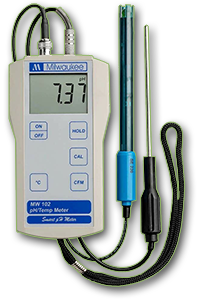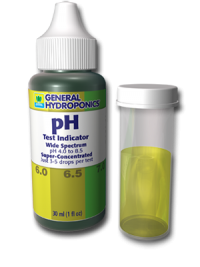Root Zone pH Monitoring
Peat is commonly used as an indoor gardening medium, but unlike coco it is quite acidic and will need its pH adjusted before use and monitored throughout the season unless you want problems. Peat is naturally acidic (pH 3.5-4.5) and will drift to become even more acidic over time. Lime should be added to raise peats pH and keep it stable over the growing season. Learn more about amending Peat here.
Signs of nutrient deficiency will appear when growing in peat if the grower isn’t keeping a close eye on the growing mediums pH on a regular basis. Often the nutrients are there in the soil but are unavailable to the plants because the pH has drifted down and has become too acidic for the plants to process. If a pH issue isn’t addressed quickly the plants will develop deficiencies due to lock out.
The following Case Study looks at 2 common scenarios one might use when growing with an inert medium like peat. When problems become apparent you will have to act quickly.
Scenario 1 - Growing with Chemical Nutrients
Setup:
- Growing Medium: Peat, Perlite, Dolomite Lime
- Some Form of Hydroponic Salt Fertilizer
- Reverse Osmosis Filtered Water
- Gen Hydro pH Up
In this scenario the growing medium is pH adjusted and stabilized with only Dolomite lime (6.4) and the water/nutrient solution is pH adjusted to 6.4 for optimum nutrient availability (read more about buffering peat). Since the major variables are accounted for this grower should have a positive growing season as long as the amount of nutrient being used is in line with the plants stage of development.
* Avoid liquid hydroponic nutrients unless you are able to use the entire bottle within 6 months. Some have a short shelf life, the minerals fall out of the solution making them useless. Even then you are still basically paying to ship water. You are better off finding a good, dry, water soluble hydroponic fertilizer that can sit on the shelf for years. Avoid all the big box store products like Miracle Grow and Expert Gardener when growing indoors with a medium like peat & perlite because they contain nutrients (urea nitrogen) that need to break down over time before becoming available to plants.
Scenario 2 - Growing with Osmocote Time Release Fertilizer
Setup:
- Growing Medium: Peat, Perlite, Dolomite Lime
- Osmocote 15-9-12
- Reverse Osmosis Filtered Water
- Gen Hydro pH Up
In this scenario the growing medium is pH adjusted and stabilized with Dolomite lime (6.4) and the water is pH adjusted to 6.4 for optimum nutrient availability (read more about buffering peat). Osmocote is mixed into the top layer of growing medium per instructions on bag. Pretty simple, now all that is needed is regular watering using pH adjusted RO water…right? The grower in this scenario will develop a nutrient lock out problem due to drifting root zone pH that will get progressively worse over time. The problem in this scenario is that pouring the pH adjusted water over the acidic Osmocote in the soil will lower the pH in the root zone leaving the plants to sit in an increasingly acidic nutrient solution after watering. So the grower using this setup forgot to account for Osmocotes acidic pH. The fix for this example is to adjust the pH of the RO water up to around 8-8.5. Now when that water passes over the acidic granules the resulting nutrient solution in the root zone will have a pH of around 6.4 which is better for your plants when grown in an inert medium like peat or coco. Read more about growing Cannabis with Time Release Nutrients like Osmocote.

How to test the soil pH
Test your soils pH regularly throughout the season for whatever scenario you are using to know exactly what your plants are dealing with at the root zone. If the soils pH is too acidic you may need to apply lime to buffer it, if you are off by just a few 10ths of a point you can just adjust your water or nutrient solution. It is important to retest regularly during the season as the pH of the water from the tap will change throughout the year and the lime used to buffer peat will also be used up by the plant. Get specific peat pH buffering details here. Testing your soils root zone pH is simple:
- Take 1/4 cup of soil from the plant container and put it in a glass jar.
- Pour 1/2 cup of your pH adjusted water (6.4) into the glass.
- Thoroughly shake to mix together.
- Filter the soil and water mixture into a new glass using.
- Test the pH of the resulting solution using a reliable pH meter.
Soil pH is a fluctuating variable when growing cannabis in peat and has to be monitored regularly throughout the growing season with periodic runoff testing if you want to be successful.


